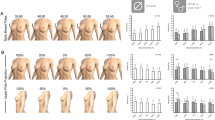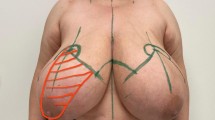Abstract
Breast ptosis classification systems focus on the inferior descent of the nipple, as well as the descent and distribution of the breast parenchyma below the inframammary fold. Common problems, such as development of a superior pole hollow and an excessive width of the superior pole, extending into the axilla, are not addressed. Few procedures specifically address these deficiencies, and even less information is available in terms of preventative maneuvers when augmentation is desired as an adjunct. Round implants worsen the problem by creating a superior pole shelf, and anatomic implants are unreliable alternatives. Here, we present a technique—“tear-drop” augmentation mastopexy—that addresses superior pole hollow, excess superior pole width, as well as breast ptosis and hypomastia. Patients with moderate to severe breast ptosis (Regnault’s classification), tubular breast deformity, and deformities secondary to previous breast surgery are included in the study. Skin is deepithelialized through a circumareolar incision, and a skin-fat flap is elevated completely encircling the breast. A 2-cm area of parenchyma is left attached to the skin in the lower half of the breast. Breast parenchyma in the superior half of the breast is then advanced and plicated in a superiomedial direction to move the nipple areolar complex to the desired new position. Care is taken to redefine the pectoralis major muscle at its axillary border. A 3-cm incision is then placed in the inferior part of the parenchyma at the 6 o’clock position to create a subpectoral pocket for placement of the implant. The tunnel is then closed to separate the implant pocket from the subcutaneous dissection. Residual dermal flap is used to define, and add durability to the parenchyma reshaping procedure. A 3-0 mersiline (Ethicon, Somerville, NJ) blocking suture is used for a uniform circumareolar skin closure. Patients (n:35), ages 17–48, underwent “tear-drop” augmentation mastopexy between January 1999 and September 2002 for correction of the breast ptosis, tubular breast deformity, and deformities secondary to previous aesthetic breast surgery. The average follow-up was 2 years. All patients displayed type 1 or 2 (Baker classification) capsules. One subcutaneous hematoma and one subcutaneous seroma were seen, which were both treated by percutaneous aspiration. No submuscular hematomas, infections, skin or nipple losses, or hypertrophic scars were noted. Patient satisfaction was high. A more natural “tear-drop” breast shape was created with an improvement in the superior pole hollow and narrowing of the superior breast. The smallest breasts did not benefit from this technique for elimination of the superior pole shelf, as correction was proportional to the amount of breast tissue available for superior advancement. The “tear-drop” augmentation mastopexy is a novel technique for correction of the breast ptosis with augmentation, avoiding problematic development of superior pole hollow and excess superior width. This technique is also well applied to tubular breast deformity as well as to secondary breast procedures. Long-term follow-up demonstrates a safe and reproducible result with high patient satisfaction. This technique may solve several problems associated with breast ptosis surgery, which before were not specifically addressed, and the technique warrants further investigation.








Similar content being viewed by others
References
E Lexer (1921) ArticleTitleCorrection de los pechos pendulos (Mastoptose) por medio de la implantacion de grasa. Guipuzcoa Medica 63 213
L Dartigues (1925) ArticleTitleTraitement chirurgical du prolapsus mammaire. Arch Franco-Belges de chir 28 313
UT Hinderer (1969) Primera experiencia con una nueva tecnica de mastoplastia para ptosis ligeras. VI Reunion Nacional de la Sociedad Espanola de Cirugia Plastica y Reparadora. Noticias Medicas Madrid, Spain 26
JCS Goes (1989) ArticleTitlePeriareolar mammaplasty: double skin technique. Rev Soc Bras Cir Plast 4 55
L Benelli (1990) ArticleTitleA new periareolar mammaplasty: round block technique. Aesth Plast Surg 14 99
Author information
Authors and Affiliations
Corresponding author
Rights and permissions
About this article
Cite this article
Ceydeli, A., Freund, R.M. “Tear-Drop Augmentation Mastopexy”: A Technique to Augment Superior Pole Hollow . Aesth. Plast. Surg. 27, 425–432 (2003). https://doi.org/10.1007/s00266-003-3053-7
Published:
Issue Date:
DOI: https://doi.org/10.1007/s00266-003-3053-7




